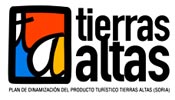
14 municipalities are included in the Mancommunity of the Highlands (click on the names to read more about them):
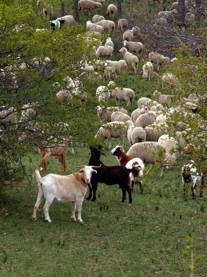 Since ancient times, the life in the Highlands has been marked by transhumance. Transhumance refers to the seasonal movement of cattle throughout certain paths to maximize the explotation of natural pastures during the whole of the year. It has marked the landscape and the character of the people that used to live around it.
Since ancient times, the life in the Highlands has been marked by transhumance. Transhumance refers to the seasonal movement of cattle throughout certain paths to maximize the explotation of natural pastures during the whole of the year. It has marked the landscape and the character of the people that used to live around it.
As it is written in the book Oncala Ayer y Hoy written by Mr. Pedro Iglesia Hernández “we should end this part about transhumance as it really was, a jouney of five men along the Royal Cattle Path, with fifteen mares, five or six mastiffs and a thousand heads of merine bovine cattle that left from Oncala and, after a month walking, arrived to a pasture in the Alcudia Valley. There were no guides or maps, only the orientation and the knowledge of previous journeys. I would like to ask the reader: how would you feel if you had to get up the first of October, say goodbye to your wife and children and start such a journey? They walked around 20 km each day for a month, taking care of the cattle (that goes back and forwards) and eating a poor diet: migas (fried bread) and torreznos (bacon) for lunch and breakfast and a potatoe stew with some cod, meat or fat for dinner.
They had to sleep on the ground, using a couple of blankets as mattress and wearing the same clothes. One of them had to stay awake. They felt lucky if the weather was good, but if it rained sheep did not want to walk or eat, so they stayed in a row and the shepherds had to carry heavy oilskins.”
[Learn more about the trashumance]
 “The most unusual thing you can ever imagine during a festival is that a group of men just roll up their throusers and start stepping over a mattress made of ember. This boldness is only possible during the night of San Juan (St John) in the town of San Pedro Manrique (Soria), on the night of the 23rd of June”, said the headline of El País magazine, 24th of June 1984. Emilia Piñero and Igor Reyes were the authors of this report. “‘Celtic Rite’, ‘purification rite’, ‘sun and fire-worship', are some of the explanations at which many anthropologists, historians and experts have came. Everything is possible and every interpretation would be correct, so maybe the best we can all do is see, feel and have a look at this magic rite”.
“The most unusual thing you can ever imagine during a festival is that a group of men just roll up their throusers and start stepping over a mattress made of ember. This boldness is only possible during the night of San Juan (St John) in the town of San Pedro Manrique (Soria), on the night of the 23rd of June”, said the headline of El País magazine, 24th of June 1984. Emilia Piñero and Igor Reyes were the authors of this report. “‘Celtic Rite’, ‘purification rite’, ‘sun and fire-worship', are some of the explanations at which many anthropologists, historians and experts have came. Everything is possible and every interpretation would be correct, so maybe the best we can all do is see, feel and have a look at this magic rite”.
You can see the special colour of the sky when sunset and bonefire are one on the evening of the 23rd of June in San Pedro Manrique.
You can look and feel the expert hands preparing with care and love the 1,000 kilogrames pyre made of oak trees. They build it up in a rectangle shape, so when it is burnt it can be spread as a carpet of embers of about 3 m long and 15 cm thick.
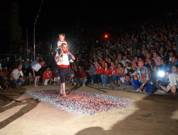 This rite is held in the amphitheater of the chapel of Virgen de la Peña (Virgin of the Rock). From 2,000 to 4,000 people follow this amazing rite about which they have heard but cannot believe. On stage, pasadores (who walk on the embers), mondidas, companions and preparadores (the ones who prepare the rite) dance around the fire.
This rite is held in the amphitheater of the chapel of Virgen de la Peña (Virgin of the Rock). From 2,000 to 4,000 people follow this amazing rite about which they have heard but cannot believe. On stage, pasadores (who walk on the embers), mondidas, companions and preparadores (the ones who prepare the rite) dance around the fire.
A shiver runs down the spine when, in the middle of the silence, a man from the town rolls up his trousers to his knees and - carrying another person on his shoulders (mondida, girlfriend, friend, wife, son, neighbour...) - walks along the ember carpet with determined steps. It is not important if he gets burnt or not, the only thing that matters is his audacity and daring, as well as the sparks that come up at each step.The audience can feel the heat of the embers mixing with the warmth of the claps and hugs among the pasadores.
If you ask any of the pasadores about the origin of the fire, they will simply answer: “It has always been like this” and it means probably that their reasons have nothing to do with its origin. The objective and origin of this rite, from a historic point, is completely different from the one – subjective, individual and essential - given by each pasador.
Some people just follow their father’s or grandfather's steps, others just do it as a promise to the Virgen de la Peña, some just do it to prove themselves that they can do it... there are a lot of reasons, but for everyboy in this town the Paso del Fuego is something that belongs to their own identity.
 Each one has each their own technique to walk along the fire: long steps, short steps, fast, slowly… The older ones step in with the confidence and calm they’ve acquired through experience. The younger ones do it with the power and vitality of their youth. Some of them even danced the jota on the embers, as “Tío Ratón” and “El Santi” who are always in our minds, specially on the night of San Juan.
Each one has each their own technique to walk along the fire: long steps, short steps, fast, slowly… The older ones step in with the confidence and calm they’ve acquired through experience. The younger ones do it with the power and vitality of their youth. Some of them even danced the jota on the embers, as “Tío Ratón” and “El Santi” who are always in our minds, specially on the night of San Juan.
(Written by Nati del Rincón, published by the journal Diario de Soria in 1991)
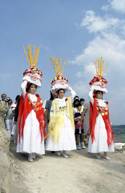 “After the magic night of St John, the festival goes on in the morning and the MONDIDAS play the leading role. As with the fire rite, the mondidas meaning and origin are unknown, with two main theories: the one that remember the hundred ladies, the Conquest and the later Reconquest from the Moorish; and the one by the anthropologist Caro Baroja, who states that it has a Roman origin based on the so called “Ceralia”, or the Spring party in honor to Ceres, Goddes of fertility and agriculture. The second one is much more to the point."
“After the magic night of St John, the festival goes on in the morning and the MONDIDAS play the leading role. As with the fire rite, the mondidas meaning and origin are unknown, with two main theories: the one that remember the hundred ladies, the Conquest and the later Reconquest from the Moorish; and the one by the anthropologist Caro Baroja, who states that it has a Roman origin based on the so called “Ceralia”, or the Spring party in honor to Ceres, Goddes of fertility and agriculture. The second one is much more to the point."
The Mondidas are three single women aged between 18 and 27 chosen by drawing lots on the 3rd on May, the Cross of May day. This year (1991), ten women were the candidates. Marka, one of the Móndidas, reports it as follows: The day of the drawing I was in Logroño, but I felt extremely nervous. The previous days are very exciting, and specially the 3rd of May; not only for the girls, but for their mothers as well because they have to get everything ready for them. The drawing takes place on the Town Hall. Marka says: “when I knew that I had been elected, I felt both annoyed and happy".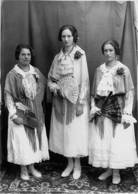 Annoyed because I like taking part on the party without any concern and because I had some exams on those days and I had to change them. And happy because I really wanted to represent my town on those days, and this feeling made me forget everything else. Everything has to be organized from that day until the day of San Juan: you have to look for somebody to write the cuarteta for you (a kind of romance that the Móndidas read as a welcoming and explanation to the festival, as well as a reflection of the social reality of the town and region. You have to prepare the skirt, underskirt, ribbons, pins, cestaño, shawl, comb, mantilla... to learn and rehearse the cuarteta, to learn how to carry the cestaño, to look for the mayo, to starch and iron the dress and, to finish with the preparations, to bake the rosquillos (doughnuts) that will be given to locals and foreigners.
Annoyed because I like taking part on the party without any concern and because I had some exams on those days and I had to change them. And happy because I really wanted to represent my town on those days, and this feeling made me forget everything else. Everything has to be organized from that day until the day of San Juan: you have to look for somebody to write the cuarteta for you (a kind of romance that the Móndidas read as a welcoming and explanation to the festival, as well as a reflection of the social reality of the town and region. You have to prepare the skirt, underskirt, ribbons, pins, cestaño, shawl, comb, mantilla... to learn and rehearse the cuarteta, to learn how to carry the cestaño, to look for the mayo, to starch and iron the dress and, to finish with the preparations, to bake the rosquillos (doughnuts) that will be given to locals and foreigners.
The day befote San Juan, the cestaño, a basquet in the shape of a truncated cone, is made by a municipal employee. Inside the cestaño, the cakes, doughnuts and arbujuelos (brenches covered by baked bread and dyed with saffron) will be placed. Together with three spades, it will be raised on a pyramid. The brenches are tied so they are fixed and some stones are placed inside as counterweight. Everything is tied with white braid and decorated with a pink ribbon and finally covered with roses.
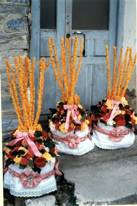 The morning of the 23rd of June, the family and friends of the Móndida cut down the mayo, which is the most beautiful tree sellected by the girl. The tree is decorated with doughnuts, ribbons and lights and it is placed in front of the house of each Móndida.
The morning of the 23rd of June, the family and friends of the Móndida cut down the mayo, which is the most beautiful tree sellected by the girl. The tree is decorated with doughnuts, ribbons and lights and it is placed in front of the house of each Móndida.
In the afternoon, the procession from the chapel of the Peña to the Humilladero takes place. The people from the town carry on their shoulders the figures of San Pedro and the Virgen de la Peña. The Mondidas follow the figures wearing a long skirt, white blouse and a silk ribbon around their waists.
Once the Virgen is relocated in the chapel, everybody goes to the main square to dance until the begining of the bonfire. The 24th of June at dawn, the descubierta begins, and the people go around the town celebrating the expulsion of the Moorish.
The tour begins at the Town Hall. Some men ride on horses without a mount and the winners are awarded with a rosco. This tradition may represent the victory over the Moorish that meant the end of the so-called tax of the Hundred Maidens.
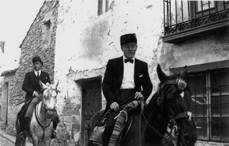 A Mass is celebrated as well as the arbujuelo. The Móndidas, dressed in white, are sitted among the Town Mayor and other people from the town council. They offer the arbujuelo they offer their first arbujuelo to the priest and the second to the major. The deputy mayor gets the last one. The other Móndidas give their arbujuelos to the other councilmen.
A Mass is celebrated as well as the arbujuelo. The Móndidas, dressed in white, are sitted among the Town Mayor and other people from the town council. They offer the arbujuelo they offer their first arbujuelo to the priest and the second to the major. The deputy mayor gets the last one. The other Móndidas give their arbujuelos to the other councilmen.
Meanwhile the youngsters have cut the highest poplar, called mayo. After the Mass, the men of San Pedro put in the mayo. Once it is erected, the Móndidas begin to read their lines. To finish up, they all dance the traditional dance called Jota.
(Written by Luisa Ruiz, published by the journal Diario de Soria in 1991)
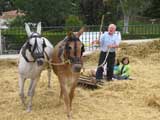
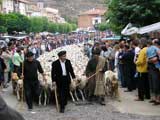
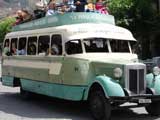
It is held in August in memory of the one that used to be celebrated every Monday in Cosa square. All the neighbours of the region used to go there to sell and buy products such as fruits, vegetables, meat, groceries and cattle. In the 1960’s it stopped working and the Town Hall decided to run it again at the end of the 1990's. Some exhibitions of old customs and trades are done, such as shearing of sheeps and donkeys, forge, threshing, old machinery, driving of cattle, basketwork... everything supported by more that fifty exhibitors that offer their products to the public.
- [ Aldehalices ]
- [ Las Aldehuelas ]
- [ Cerbón ]
- [ Castilfrío de la Sierra ]
- [ Estepa de San Juan ]
- [ Fuentes de Magaña ]
- [ Magaña ]
- [ Oncala ]
- [ San Pedro Manrique ]
- [ Santa Cruz de Yanguas ] [www.santacruzdeyanguas.com]
- [ Valtajeros ]
- [ Villar del Rio ]
- [ Vizmanos ]
- [ Yanguas ]
- [ Valdeprado ]
Etnography
THE TRANSHUMANCE ON THE HIGHLANDS
 Since ancient times, the life in the Highlands has been marked by transhumance. Transhumance refers to the seasonal movement of cattle throughout certain paths to maximize the explotation of natural pastures during the whole of the year. It has marked the landscape and the character of the people that used to live around it.
Since ancient times, the life in the Highlands has been marked by transhumance. Transhumance refers to the seasonal movement of cattle throughout certain paths to maximize the explotation of natural pastures during the whole of the year. It has marked the landscape and the character of the people that used to live around it.
As it is written in the book Oncala Ayer y Hoy written by Mr. Pedro Iglesia Hernández “we should end this part about transhumance as it really was, a jouney of five men along the Royal Cattle Path, with fifteen mares, five or six mastiffs and a thousand heads of merine bovine cattle that left from Oncala and, after a month walking, arrived to a pasture in the Alcudia Valley. There were no guides or maps, only the orientation and the knowledge of previous journeys. I would like to ask the reader: how would you feel if you had to get up the first of October, say goodbye to your wife and children and start such a journey? They walked around 20 km each day for a month, taking care of the cattle (that goes back and forwards) and eating a poor diet: migas (fried bread) and torreznos (bacon) for lunch and breakfast and a potatoe stew with some cod, meat or fat for dinner.
They had to sleep on the ground, using a couple of blankets as mattress and wearing the same clothes. One of them had to stay awake. They felt lucky if the weather was good, but if it rained sheep did not want to walk or eat, so they stayed in a row and the shepherds had to carry heavy oilskins.”
[Learn more about the trashumance]
EL PASO DEL FUEGO (WALKING OVER THE FIRE): A RITE & AN EXPERIENCE
 “The most unusual thing you can ever imagine during a festival is that a group of men just roll up their throusers and start stepping over a mattress made of ember. This boldness is only possible during the night of San Juan (St John) in the town of San Pedro Manrique (Soria), on the night of the 23rd of June”, said the headline of El País magazine, 24th of June 1984. Emilia Piñero and Igor Reyes were the authors of this report. “‘Celtic Rite’, ‘purification rite’, ‘sun and fire-worship', are some of the explanations at which many anthropologists, historians and experts have came. Everything is possible and every interpretation would be correct, so maybe the best we can all do is see, feel and have a look at this magic rite”.
“The most unusual thing you can ever imagine during a festival is that a group of men just roll up their throusers and start stepping over a mattress made of ember. This boldness is only possible during the night of San Juan (St John) in the town of San Pedro Manrique (Soria), on the night of the 23rd of June”, said the headline of El País magazine, 24th of June 1984. Emilia Piñero and Igor Reyes were the authors of this report. “‘Celtic Rite’, ‘purification rite’, ‘sun and fire-worship', are some of the explanations at which many anthropologists, historians and experts have came. Everything is possible and every interpretation would be correct, so maybe the best we can all do is see, feel and have a look at this magic rite”.You can see the special colour of the sky when sunset and bonefire are one on the evening of the 23rd of June in San Pedro Manrique.
You can look and feel the expert hands preparing with care and love the 1,000 kilogrames pyre made of oak trees. They build it up in a rectangle shape, so when it is burnt it can be spread as a carpet of embers of about 3 m long and 15 cm thick.
 This rite is held in the amphitheater of the chapel of Virgen de la Peña (Virgin of the Rock). From 2,000 to 4,000 people follow this amazing rite about which they have heard but cannot believe. On stage, pasadores (who walk on the embers), mondidas, companions and preparadores (the ones who prepare the rite) dance around the fire.
This rite is held in the amphitheater of the chapel of Virgen de la Peña (Virgin of the Rock). From 2,000 to 4,000 people follow this amazing rite about which they have heard but cannot believe. On stage, pasadores (who walk on the embers), mondidas, companions and preparadores (the ones who prepare the rite) dance around the fire.
A shiver runs down the spine when, in the middle of the silence, a man from the town rolls up his trousers to his knees and - carrying another person on his shoulders (mondida, girlfriend, friend, wife, son, neighbour...) - walks along the ember carpet with determined steps. It is not important if he gets burnt or not, the only thing that matters is his audacity and daring, as well as the sparks that come up at each step.The audience can feel the heat of the embers mixing with the warmth of the claps and hugs among the pasadores.
If you ask any of the pasadores about the origin of the fire, they will simply answer: “It has always been like this” and it means probably that their reasons have nothing to do with its origin. The objective and origin of this rite, from a historic point, is completely different from the one – subjective, individual and essential - given by each pasador.
Some people just follow their father’s or grandfather's steps, others just do it as a promise to the Virgen de la Peña, some just do it to prove themselves that they can do it... there are a lot of reasons, but for everyboy in this town the Paso del Fuego is something that belongs to their own identity.
 Each one has each their own technique to walk along the fire: long steps, short steps, fast, slowly… The older ones step in with the confidence and calm they’ve acquired through experience. The younger ones do it with the power and vitality of their youth. Some of them even danced the jota on the embers, as “Tío Ratón” and “El Santi” who are always in our minds, specially on the night of San Juan.
Each one has each their own technique to walk along the fire: long steps, short steps, fast, slowly… The older ones step in with the confidence and calm they’ve acquired through experience. The younger ones do it with the power and vitality of their youth. Some of them even danced the jota on the embers, as “Tío Ratón” and “El Santi” who are always in our minds, specially on the night of San Juan.
(Written by Nati del Rincón, published by the journal Diario de Soria in 1991)
MONDIDAS
 “After the magic night of St John, the festival goes on in the morning and the MONDIDAS play the leading role. As with the fire rite, the mondidas meaning and origin are unknown, with two main theories: the one that remember the hundred ladies, the Conquest and the later Reconquest from the Moorish; and the one by the anthropologist Caro Baroja, who states that it has a Roman origin based on the so called “Ceralia”, or the Spring party in honor to Ceres, Goddes of fertility and agriculture. The second one is much more to the point."
“After the magic night of St John, the festival goes on in the morning and the MONDIDAS play the leading role. As with the fire rite, the mondidas meaning and origin are unknown, with two main theories: the one that remember the hundred ladies, the Conquest and the later Reconquest from the Moorish; and the one by the anthropologist Caro Baroja, who states that it has a Roman origin based on the so called “Ceralia”, or the Spring party in honor to Ceres, Goddes of fertility and agriculture. The second one is much more to the point."The Mondidas are three single women aged between 18 and 27 chosen by drawing lots on the 3rd on May, the Cross of May day. This year (1991), ten women were the candidates. Marka, one of the Móndidas, reports it as follows: The day of the drawing I was in Logroño, but I felt extremely nervous. The previous days are very exciting, and specially the 3rd of May; not only for the girls, but for their mothers as well because they have to get everything ready for them. The drawing takes place on the Town Hall. Marka says: “when I knew that I had been elected, I felt both annoyed and happy".
 Annoyed because I like taking part on the party without any concern and because I had some exams on those days and I had to change them. And happy because I really wanted to represent my town on those days, and this feeling made me forget everything else. Everything has to be organized from that day until the day of San Juan: you have to look for somebody to write the cuarteta for you (a kind of romance that the Móndidas read as a welcoming and explanation to the festival, as well as a reflection of the social reality of the town and region. You have to prepare the skirt, underskirt, ribbons, pins, cestaño, shawl, comb, mantilla... to learn and rehearse the cuarteta, to learn how to carry the cestaño, to look for the mayo, to starch and iron the dress and, to finish with the preparations, to bake the rosquillos (doughnuts) that will be given to locals and foreigners.
Annoyed because I like taking part on the party without any concern and because I had some exams on those days and I had to change them. And happy because I really wanted to represent my town on those days, and this feeling made me forget everything else. Everything has to be organized from that day until the day of San Juan: you have to look for somebody to write the cuarteta for you (a kind of romance that the Móndidas read as a welcoming and explanation to the festival, as well as a reflection of the social reality of the town and region. You have to prepare the skirt, underskirt, ribbons, pins, cestaño, shawl, comb, mantilla... to learn and rehearse the cuarteta, to learn how to carry the cestaño, to look for the mayo, to starch and iron the dress and, to finish with the preparations, to bake the rosquillos (doughnuts) that will be given to locals and foreigners. The day befote San Juan, the cestaño, a basquet in the shape of a truncated cone, is made by a municipal employee. Inside the cestaño, the cakes, doughnuts and arbujuelos (brenches covered by baked bread and dyed with saffron) will be placed. Together with three spades, it will be raised on a pyramid. The brenches are tied so they are fixed and some stones are placed inside as counterweight. Everything is tied with white braid and decorated with a pink ribbon and finally covered with roses.
 The morning of the 23rd of June, the family and friends of the Móndida cut down the mayo, which is the most beautiful tree sellected by the girl. The tree is decorated with doughnuts, ribbons and lights and it is placed in front of the house of each Móndida.
The morning of the 23rd of June, the family and friends of the Móndida cut down the mayo, which is the most beautiful tree sellected by the girl. The tree is decorated with doughnuts, ribbons and lights and it is placed in front of the house of each Móndida.
In the afternoon, the procession from the chapel of the Peña to the Humilladero takes place. The people from the town carry on their shoulders the figures of San Pedro and the Virgen de la Peña. The Mondidas follow the figures wearing a long skirt, white blouse and a silk ribbon around their waists.
Once the Virgen is relocated in the chapel, everybody goes to the main square to dance until the begining of the bonfire. The 24th of June at dawn, the descubierta begins, and the people go around the town celebrating the expulsion of the Moorish.
The tour begins at the Town Hall. Some men ride on horses without a mount and the winners are awarded with a rosco. This tradition may represent the victory over the Moorish that meant the end of the so-called tax of the Hundred Maidens.
 A Mass is celebrated as well as the arbujuelo. The Móndidas, dressed in white, are sitted among the Town Mayor and other people from the town council. They offer the arbujuelo they offer their first arbujuelo to the priest and the second to the major. The deputy mayor gets the last one. The other Móndidas give their arbujuelos to the other councilmen.
A Mass is celebrated as well as the arbujuelo. The Móndidas, dressed in white, are sitted among the Town Mayor and other people from the town council. They offer the arbujuelo they offer their first arbujuelo to the priest and the second to the major. The deputy mayor gets the last one. The other Móndidas give their arbujuelos to the other councilmen.
Meanwhile the youngsters have cut the highest poplar, called mayo. After the Mass, the men of San Pedro put in the mayo. Once it is erected, the Móndidas begin to read their lines. To finish up, they all dance the traditional dance called Jota.
(Written by Luisa Ruiz, published by the journal Diario de Soria in 1991)
TRADITIONAL MARKET OF SAN PEDRO MANRIQUE



It is held in August in memory of the one that used to be celebrated every Monday in Cosa square. All the neighbours of the region used to go there to sell and buy products such as fruits, vegetables, meat, groceries and cattle. In the 1960’s it stopped working and the Town Hall decided to run it again at the end of the 1990's. Some exhibitions of old customs and trades are done, such as shearing of sheeps and donkeys, forge, threshing, old machinery, driving of cattle, basketwork... everything supported by more that fifty exhibitors that offer their products to the public.
THE SLAUGHTER ON THE HIGHLANDS
The products derived from the slaughter provided all the necessary food for the whole of the year: chorizo (red, spicy sausage), cured loin, backbone, fat, hoofs, black pudding, lard... even the tail.
The traditional way of slaughter is very different from the present one. The pig stopped eating two days before so that the intestines would be as clean as possible. The first part of the slaughter was to tie up the pig firmly so it cannot move. Then, a hook was located on its chin as it was raised to the slaughter bench. Once the animal had been raised, the ropes were tightened. So the pig cannot move anymore. The slaughterman would hold the hook under his leg so that both his hands would be free. He could start his work then. The slaughtermen should cut the jugular directly and firmly, so the pig loses all its blood and the meat stays clear and white. The blood was used to make the black pudding. It was removed with a spoon and mxed with bread, salted water, and boiled rice.
Ears and hoofs were cut to be cleaned apart. Then the pork was scrapped with stones, lids and hot water, until it was clean and it could be slit it open at the owner’s house where it had been relocated.
Then the pork was chopped up starting from the fat located under its belly. Then it was hanged from its legs so that the guts could be withdrawn, as well as the bladder, spleen, lungs, stomach and heart. The liver, stomach and heart were washed and boiled to make the güeñas, which was the first meat to be eaten. Women used to wash the guts in the cold river waters first and then in hot water at home. The guts were cut and divided in order to make the black pudding and the chorizo (red spicy sausage). The pieces of fat located at the guts were mixed with sugar, anisette and dough to make the typical cake called tortas de chichorras. Once all the fat was withdrawn, the pork was kept hung for a night to get the meat ready for the next day chopping. The day of the slaughter, the black pudding was made. It was a sweet one, so sugar, fat, cinnamon, anisette tea and sometimes raisins and pine nuts were added to the blood and then cooked.
During the evening, this mixture was placed into the skins, either with machines or by hand. Then the skins were sewed or tied so they would not break when boiled. The day after the slaughter the pork was chopped up. First of all the sirloin - that sometimes was a present to the priest, doctor or teacher of the town - and after that the head and the backbone, so the pork could be cut in two halves. Then the loin, rib cages, shoulders and hams. The fat was used to make the red spicy sausage and the head was baked. Some meat was mixed with fat, salt and spices and boiled to get the butifarras (white spicy sausage). Loins, rib cages, bones, backbone, paws, ears and fat were kept in salt for a couple of days. Then they were mixed with garlic, paprika, pepper and water for a day and they were dried a little bit. Finally the ribs and loins were fried and placed in a earthenware jar with olive oil to preserve them for a year. A soup was made with the bones, both ears, fat and paws. The hams were covered with salt for as many days as the kilos they weighted. Then they were washed and pressed with big stones, spreaded with a fluid that protected them from the insects and then with vinegar and paprika. For a year they were hung next to the chimneys or cookers.
The rest of the meat was chopped and minced, mixed with paprika, pepper, garlic and fat to make the red spicy sausage, or with sherry, pepper and salt to make salami sausage. Once the mixture was made, it was covered and left for a day after which all the meat was put into guts and hung in a dark place to get cured.
The butter used to be placed in the bladder so it could be preserved for a long time and it was used on toasts or to fry, cook or bake some cakes.
(Written by Fernando García La Hoz)
The traditional way of slaughter is very different from the present one. The pig stopped eating two days before so that the intestines would be as clean as possible. The first part of the slaughter was to tie up the pig firmly so it cannot move. Then, a hook was located on its chin as it was raised to the slaughter bench. Once the animal had been raised, the ropes were tightened. So the pig cannot move anymore. The slaughterman would hold the hook under his leg so that both his hands would be free. He could start his work then. The slaughtermen should cut the jugular directly and firmly, so the pig loses all its blood and the meat stays clear and white. The blood was used to make the black pudding. It was removed with a spoon and mxed with bread, salted water, and boiled rice.
Ears and hoofs were cut to be cleaned apart. Then the pork was scrapped with stones, lids and hot water, until it was clean and it could be slit it open at the owner’s house where it had been relocated.
Then the pork was chopped up starting from the fat located under its belly. Then it was hanged from its legs so that the guts could be withdrawn, as well as the bladder, spleen, lungs, stomach and heart. The liver, stomach and heart were washed and boiled to make the güeñas, which was the first meat to be eaten. Women used to wash the guts in the cold river waters first and then in hot water at home. The guts were cut and divided in order to make the black pudding and the chorizo (red spicy sausage). The pieces of fat located at the guts were mixed with sugar, anisette and dough to make the typical cake called tortas de chichorras. Once all the fat was withdrawn, the pork was kept hung for a night to get the meat ready for the next day chopping. The day of the slaughter, the black pudding was made. It was a sweet one, so sugar, fat, cinnamon, anisette tea and sometimes raisins and pine nuts were added to the blood and then cooked.
During the evening, this mixture was placed into the skins, either with machines or by hand. Then the skins were sewed or tied so they would not break when boiled. The day after the slaughter the pork was chopped up. First of all the sirloin - that sometimes was a present to the priest, doctor or teacher of the town - and after that the head and the backbone, so the pork could be cut in two halves. Then the loin, rib cages, shoulders and hams. The fat was used to make the red spicy sausage and the head was baked. Some meat was mixed with fat, salt and spices and boiled to get the butifarras (white spicy sausage). Loins, rib cages, bones, backbone, paws, ears and fat were kept in salt for a couple of days. Then they were mixed with garlic, paprika, pepper and water for a day and they were dried a little bit. Finally the ribs and loins were fried and placed in a earthenware jar with olive oil to preserve them for a year. A soup was made with the bones, both ears, fat and paws. The hams were covered with salt for as many days as the kilos they weighted. Then they were washed and pressed with big stones, spreaded with a fluid that protected them from the insects and then with vinegar and paprika. For a year they were hung next to the chimneys or cookers.
The rest of the meat was chopped and minced, mixed with paprika, pepper, garlic and fat to make the red spicy sausage, or with sherry, pepper and salt to make salami sausage. Once the mixture was made, it was covered and left for a day after which all the meat was put into guts and hung in a dark place to get cured.
The butter used to be placed in the bladder so it could be preserved for a long time and it was used on toasts or to fry, cook or bake some cakes.
(Written by Fernando García La Hoz)

© Tourist Initiatives Center of the Highlands (Soria, Spain) 2009




